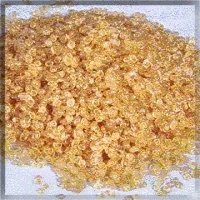

The natural protein of gelatine plays a major role in supplying the body with glycine and proline. It differs from other proteins because it contains the two amino acids in a concentrated form that is around 10 to 20 times higher than any others that allows the human body to produce collagen. The amino acids glycine and proline perform an important function for building up fibrous tissues in the human body. An insufficient supply of these amino acids can make itself known in the form of painful joints as well as brittle fingernails and hair.
In 1998, the american company Nabisco, now the parent company of Knox gelatin, sponsored a study to determine whether gelatin supplements would be helpful in rebuilding arthritic joints. Two of the amino acids found in gelatin are substances the body uses to make collagen, a component of connective tissues like cartilage.
Of course, the researchers in the study found that supplements helped to keep the joints of the athletes more flexible and helped to reduce pain. The product used in the study was Knox NutraJoint. Gelatine had a preventive and regenerative effect on the skeleton and locomotor system – especially bones, cartilage, tendons and ligaments.
Tthe Federal Drug Administration researched the safety of beef gelatin in July 2003, in oral and topical drugs, food, and cosmetics. They concluded there was no basis for objecting to gelatin use in cosmetics or products for human consumption. Their recommendation was based on gelatin derived from bones obtained from cattle from BSE-free herds or from countries that have no reported cases of BSE. The animals used must be properly processed to remove parts in the animals' heads, spines, and spinal cords directly after slaughter to prevenbt the contagion of disease.
Supplemental dosage - 1 tsp gelatine = 4 tsp jelly crystals. Just add 1 tsp of gelatine to tea or coffee daily.
Vitamin C destroys free radicals and helps preserve the integrity of cartilage and supports new growth. Vitamin B6 shrinks the inflamed synovial membrane that lines the surface of the joint, alleviating pain and restoring mobility. Improving the diet can make a difference to joint pain and stiffness simply by identifying where the problem is and taking steps to rectify it by providing what is missing.; This may be as simple as adjusting our diets to the foods used by our grandparents, like jellied foods and some of the simple supplements they also used, like magnesium and borax. Contributors to joint damage and limiting bone growth -
Breakfast Cereals
Yogurt
Margarine
Energy Bars
Cookies, Cakes, and Pies
Candy
Arthritis (wearing of the joints) and osteoporosis (pathological thinning of the solid bone substance, leading to brittle bones) are among the most well-known diseases in Europe.
Sports injuries, extreme sporting activities, heavy manual labour and wrongly loading the joints and bones lead to changes in the joints. These can lead to stiff fingers, cold feelings and swellings in the extremities. These changes are often accompanied by extreme physical pain. However, the complaints can be prevented with a healthy diet where protein intake has been optimised, for example with gelatine.
Osteoporosis (decalcification of the bones) is a disease due to the imbalance of bone minerals. As minerals are leached out for other body usage, the stability of bony tissue is eroded resulting in easy fracture. Crumbling limestone is a good example of osteoporosis.
Minerals are deposited and are the matrix and strength of the the bone. However if the there is a shortage of a particular mineral in another part of the body, a withdrawal will occur from the bone to provide for the deficit. Bone is composed of many minerals in differing proportions - calcium, phosphorus, magnesium, sodium, sulphur, potassium, zinc, manganese, copper, silicon, stronium, boron. Boron helps other minerals to incorporate into the bony matrix (Borax for arthritis is an old folk remedy). Body hormones and Vitamin D are also necessary. Bone is destroyed and replaced periodically just like leaves on a tree. Another ongoing function of bone is the manufacture of blood cells in the bone marrow. We have a continuing need for the appropriate vitamins and minerals that we should be getting these from our diet. Plants and animals can display deficiencies too, we can only get the minerals if they were in the soil in the first place.
Contributors to Bone loss and arthritis -
Gristle in our diet contains essential nutrients to repair cartilage but we don't eat it any more. We feed it to our dogs now.